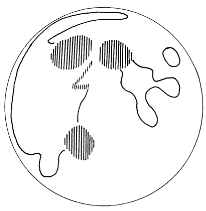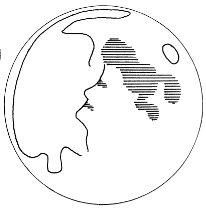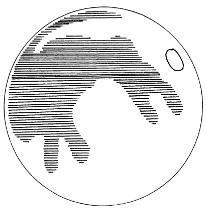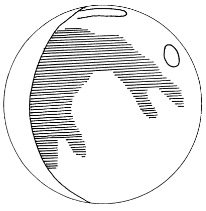Rupes Recta(straight wall)
THE STRAIGHT WALL.--Sometimes called "the railroad," is a remarkable and almost unique formation on the E. side of Birt, extending for about 65 miles from N.W. to S.E. in a nearly straight line, terminating on the south at a very peculiar mountain group, the shape of which has been compared to a stag's horn, but which perhaps more closely resembles a sword-handle,--the wall representing the blade. When examined under suitable conditions, the latter is seen to be slightly curved, the S. half bending to the east, and the remainder the opposite way. The formation is not a ridge, but is clearly due to a sudden change in the level of the surface, and thus has the outward characteristics of a "fault" Along the upper edge of this gigantic cliff (which, though measures differ, cannot be anywhere much less than 500 feet high) I have seen at different times many small craterlets and mounds. Near its N. end is a large crater, and on the E. is a row of hillocks, running at right angles to the cliff. No observer should fail to examine the wall under a setting sun when the nearly perpendicular W. face of the cliff is brilliantly illuminated.
Celestron NexStar 130SLT
I use a Celestron NexStar 130SLT Computerized Telescope (with GoTo) with a 5 inch Newtonian reflector on an altazimuth mount. NOTE: I recommend that a MOON filter (dark green lense) be used to view the full moon. It is very bright through a telescope.
I observed the following objects approximately at 8:30 pm on October 19, 2013:
Sinus Aestuum
Lacus Mortis
Palus Putredinis
Promontorium Laplace
Promontorium Hercalides
Promontorium Agarum
Montes Alpes
Montes Apenninus
Mons Hadley
Mons Piton
Mons Pico
Rupes Altai
Rima Hyginus
Vallis Schroteri
Vallis Alpes
Rupes Recta(straight wall)













 The Man in the Moon.
The Man in the Moon. The Woman in the Moon.
The Woman in the Moon. The Rabbit in the Moon.
The Rabbit in the Moon. The Cow Jumping over the Moon.
The Cow Jumping over the Moon.
